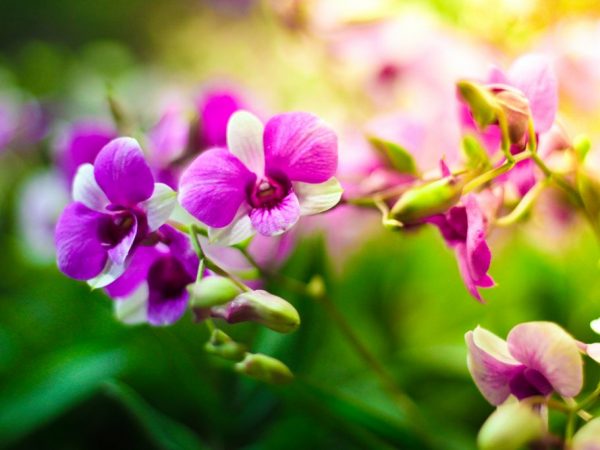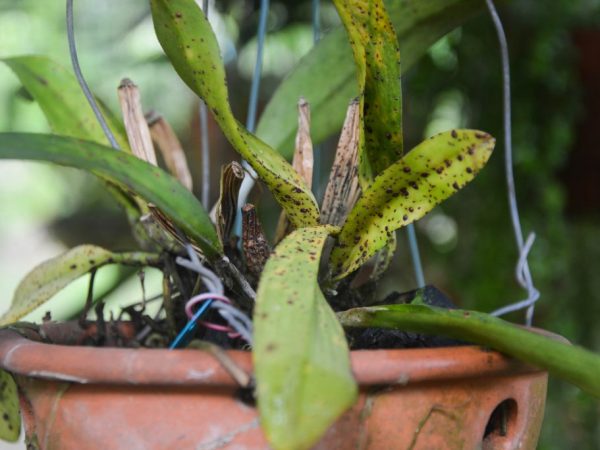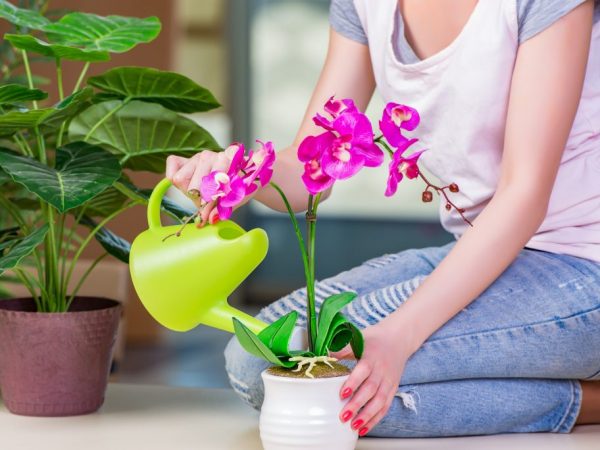How to stimulate flowering in orchids
Orchids are demanding on the conditions of keeping and do not tolerate mistakes of the owners. With incorrect watering and temperature conditions, the immunity of the flower decreases. As a result, a person loses the main purpose of growing a crop - the orchid does not bloom.

How to stimulate flowering in orchids
Why didn't the flower bloom
When growing orchids, growers try to make every effort to achieve long-term active flowering. Long-term absence of inflorescences indicates errors in the care of the crop, as well as their susceptibility to infection with fungal infections.
The reason may also be the peculiarities of the cultivated subspecies of orchids. Some varieties form an arrow, but do not open the buds until 2-3 months. You should not interfere with the development of your pet. This is her feature that a person will have to come to terms with.
Mistakes in flower care
When the orchid does not bloom at home, the owner is most often to blame. Improperly organized care affects the development of culture in different ways. The plant is able to stop growing, build up green mass or suffer from diseases. The most common causes of flowering problems are:
- Errors in the organization of watering. The soil is moistened only after it is completely dry. Use settled water with a temperature of 2 ° C-24 ° C.
- Errors in the organization of lighting. Daylight hours should be 11-12 hours. Direct sunlight destroys the plant, so it is shaded.
- Insufficient temperature difference when laying the peduncle. In order for the flower arrow to form and bloom, it is important that the difference between the air temperature readings during the day and at night is at least 5 ° C.
- Wrong choice of fertilizers. Orchids love potassium-phosphorus compounds. The predominance of nitrogen prevents the formation of inflorescences.

Improperly organized care affects the development of culture
All these problems often arise for flower growers who neglect to obtain additional knowledge about the cultivation of orchids. To observe the flowering of a home plant, all its whims should be fulfilled, focusing on the habitat of the species, the conditions of its life and normal development.
Diseases and pests
Orchids do not bloom due to the presence of fungal diseases and pests. Until the flower is cured, there is no need to wait for the appearance of inflorescences. The leaves, aerial roots, and the stem of the flower are examined for signs of damage. If they are identified, problem areas are treated with a drug designed to eliminate a specific problem.
Plant recovery is slow. After treatment, they wait several months until the plant releases beautiful buds.
Why the orchid does not bloom after transplanting
If the phalaenopsis orchid does not bloom after transplanting into a new pot, the cause is most likely the damaged root system of the plant.This type of orchid is not able to boast of resistance to stress, so it reacts poorly to soil changes. The roots of the plant can dry out and even rot. In order for home orchids to bloom, they prune damaged roots and organize high-quality care for it.
Another reason for problems with flowering after transplanting lies in the quality of the soil. It should be loose, and a poorly developed or pruned root system will cause the flower to become unstable in the pot. It is difficult to constantly deal with such a problem - it is better to cut the peduncle in order to distribute the plant's strength to the formation of a healthy root system. The only drawback is the lack of flowering while the new peduncle is growing. With proper operation and care, the plant will bloom all year round.
Is it possible to cause flowering
When an orchid does not bloom for a long time, it shows its dissatisfaction with the conditions of detention. The florist should be guided by this before looking for ways to solve the problem. They study the biological rhythms of culture, its characteristics and requirements.
In order for the plant to bloom, the correct system of irrigation and fertilization is organized. If such actions proved to be ineffective, they move on to the use of more radical measures. To make an orchid bloom:
- treated with special chemicals;
- cut off;
- exposed to artificial drought and temperature changes.
Another common method is to simulate tropical rain. Seasonal rains in the tropics last for days and weeks. At home, a pot with a plant is placed in warm water for 2-3 hours or watered abundantly (such methods are effective only for plants planted in pots with drainage holes). Favorable water temperature - 22 ° C-24 ° C.
Chemical treatment
Making an orchid bloom is easy with chemicals. Phalaenopsis and other varieties of culture are well accepted by growth stimulants. The most popular drug is Epin. In order for orchids to bloom at home, the flower is sprayed with a solution prepared according to the instructions. Phalaenopsis is watered with a similar agent no more than 4 times a month.
If the orchid does not bloom for a long time, a solution of succinic acid is used. After using such a remedy, stimulation of the growth of roots and leaves is observed. The orchid also releases babies from awakened buds. It is possible to make an orchid bloom using a solution:
- 1 tablet of succinic acid is dissolved in 0.5 l of water;
- spray the leaves, aerial roots and root collar of the plant;
- the solution remaining in the spray bottle is poured under the root of the flower.
You can make the Phalaenopsis orchid bloom according to a different scheme. The flower is soaked in a solution by dropping a pot with a plant into it for 3-4 hours (the presence of drainage holes is important). Then the plant is extracted from succinic acid and the excess liquid is allowed to drain. To stimulate the growth of foliage, roots and flowering, the procedure is repeated after 3 weeks. A positive result is seen after the first application of the chemical.

In order for the plant to bloom, organize the correct system of irrigation and fertilization
Temperature difference
If the orchid is not blooming, the temperature difference can be effective. The flower pot is placed on the balcony and left there overnight. The air temperature in the new room for the plant should not be lower than 16 ° C. In the morning, the plant is returned to its old place. As a result of these changes in housing conditions, the culture is under stress, which is why it releases a flower arrow.
The effectiveness of this method also depends on the correct care during flowering stimulation. The culture is provided with 12-hour lighting, phytolamps are used, and a tray with water is placed next to the pot, designed to increase the air humidity.
Drought simulation
The most effective way to create conditions for flowering is to arrange a drought for the plant.It's all about the natural features of orchids. Germinating in nature in the tropics, they can suffer from drought for up to 3 months, passing into a dormant period. The culture adapts to the conditions created by nature, completing the growing season.
Potted plants are less self-sufficient. Continuing to look after the flower, the person himself does not allow the plant to complete the growing season. As a result, it does not bloom, but forms new shoots. If you specifically reduce watering to a minimum, the orchid will bloom. Do not use this method with diseased flowers. Damaged roots, problems with turgor and even with flower immunity, if watering is limited, will lead to adverse consequences.
Peduncle pruning
In order for orchids to bloom, flower growers often use a method of pruning a peduncle. The main thing is to choose the right place for the cut. Using a knife, part of the peduncle is cut off 2 cm above the upper bud. Another scheme is pruning at the end of the flower rosette.
With proper care, you can get a new flower arrow in a few months. Indoor orchid will also favorably accept growth stimulation with succinic acid.
Correct fertilization
In order for the orchid to bloom, attention is paid to the choice of suitable feeding. All fertilizers are divided into 2 types: designed to stimulate the growth of roots and foliage and to stimulate the flowering process. It will not work to make an orchid bloom at home if the florist uses the first feeding option. The flower will grow foliage, strengthen the roots, but bright and beautiful buds will not appear for a long time.
To obtain an expressive flower arrow and buds, potash-phosphorus fertilizers are required. They are applied both by root method and by spraying. The main thing is not to use such compositions if the flower has damaged roots. As a result, after fertilization, it will not grow and, forming a flower arrow, will die from exhaustion.
Is it possible to cause re-flowering
Depending on the type of culture, as well as how it is looked after, the flower blooms with bright and beautiful buds. But he is able to please the owner for a short time. It usually takes a month from the moment when the bright fragrant buds of the plant open up to their wilting. Florists are unhappy with the short flowering duration and tend to go to any tricks to see the inflorescences again.

Harmonotherapy to awaken dormant kidneys
Stimulating actions help to get the plant to bloom again. Harmonotherapy has long been popular among flower growers, the use of which helps to awaken the dormant buds of a plant. The most effective remedy is cytokinin paste. Its use in 100% of cases leads to the appearance of indoor flower babies. It is applied as follows:
- The plant is examined for the presence of buds on the peduncle. For processing, only 2 kidneys are used: the uppermost and the lowest.
- Carefully cut off the upper skin of the kidney with a knife, gaining access to its green tissues.
- The paste is squeezed onto a needle or toothpick (no more than 2 g) and the prepared kidneys are coated with it.
With the correct use of cytokinin paste, a new peduncle appears again after a week. The main thing is not to exceed the dosage and not to paste over the leaves and roots. Also, do not handle more than 3 kidneys.
Conclusion
If orchids do not bloom, but there is an increase in roots and leaves, you should reconsider the features of care. Changing the watering and feeding regime stimulates the plant to bloom. If these methods are ineffective, they use chemical stimulants or put the flower under stress.


